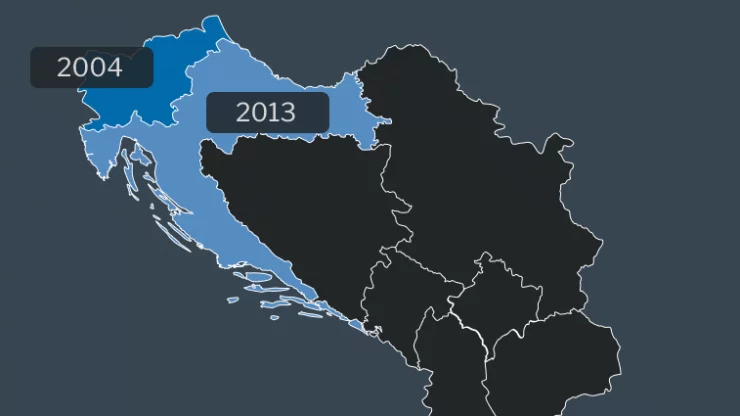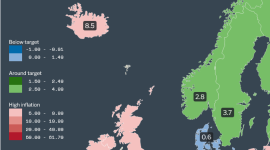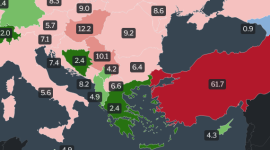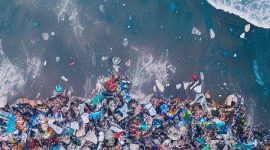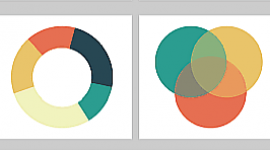This article covers indicators like GDP per capita, PPP per capita, HDI, life expectancy at birth, as well as the membership in the EU, NATO, the Eurozone, and the Schengen area.
We start with the general overview showing a visualization of 8 different dimensions followed by an in-depth discussion about each later in the post.
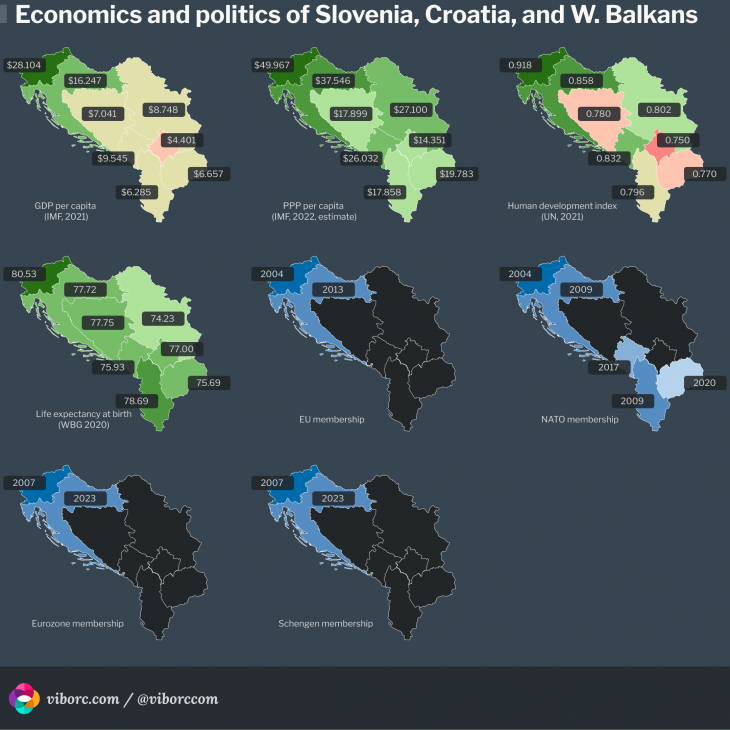
GDP per capita
GDP per capita is a measure of a country’s economic output per person and is often used as an indicator of the standard of living in a country. Slovenia has a GDP per capita of $28,104, while Croatia’s is $16,247. In comparison, the GDP per capita of the other WB6 countries is much lower, with Bosnia and Herzegovina at $7,041, Serbia at $8,748, Montenegro at $9,545, Kosovo at $4,401, North Macedonia at $6,557, and Albania at $6,285. Slovenia and Croatia have a higher GDP per capita than the other WB6 countries, which may contribute to a higher standard of living in these countries.
| COUNTRY | GDP PER CAPITA |
|---|---|
| Slovenia | $28,104 |
| Croatia | $16,247 |
| Montenegro | $9,545 |
| Serbia | $8,748 |
| Bosnia and Herzegovina | $7,041 |
| North Macedonia | $6,557 |
| Albania | $6,285 |
| Kosovo | $4,401 |
Data source: IMF, 2021
PPP per capita
PPP per capita is another measure of the standard of living that considers the cost of living in a country. Slovenia has a PPP per capita of $49,967, while Croatia’s is $37,546. The PPP per capita of the other WB6 countries is lower, with Bosnia and Herzegovina at $17,899, Serbia at $27,100, Montenegro at $26,032, Kosovo at $14,351, North Macedonia at $19,783, Albania at $17,858. Similar to GDP per capita, Slovenia and Croatia have higher PPP per capita compared to the other WB6 countries, indicating a higher standard of living in these countries.
| COUNTRY | PPP (per capita) |
|---|---|
| Slovenia | $49,967 |
| Croatia | $37,546 |
| Serbia | $27,100 |
| Montenegro | $26,032 |
| North Macedonia | $19,783 |
| Bosnia and Herzegovina | $17,899 |
| Albania | $17,858 |
| Kosovo | $14,351 |
Data source: IMF, 2022 estimate
Difference between GDP and PPP per capita
GDP (gross domestic product) per capita is a measure of a country’s economic output per person and is often used as an indicator of the standard of living in a country. It is calculated by dividing the total GDP of a country by its population. GDP per capita is a helpful measure for comparing the economic output of different countries, but it does not consider the cost of living in these countries.
On the other hand, PPP (purchasing power parity) per capita is a measure of the standard of living in a country that considers the cost of living. PPP, or purchasing power parity, is a measure of the exchange rate between countries that considers the difference in the cost of goods and services between countries. PPP per capita is calculated by dividing the PPP of a country by its population. Therefore, PPP per capita is a more accurate measure of the standard of living in a country compared to GDP per capita, as it considers the country’s cost of living.
For example, consider two countries, A and B, with the following characteristics:
- Country A: GDP per capita = $30,000, PPP per capita = $30,000
- Country B: GDP per capita = $20,000, PPP per capita = $40,000
Based on GDP per capita, country A may seem to have a higher standard of living compared to country B. However, when we consider the PPP per capita, we see that the cost of living in country B is lower than in country A, meaning that the standard of living in country B is higher than in country A.
PPP per capita is a more accurate measure of the standard of living in this case, as it takes into account the cost of living in the two countries.
HDI
The Human Development Index (HDI) measures a country’s overall well-being, assessing factors such as life expectancy, education, and standard of living. It ranks countries worldwide, and the United Nations Development Programme (UNDP) puts it out every year.
The HDI is calculated based on three dimensions:
- A long and healthy life: considers life expectancy at birth.
- Access to knowledge takes into account the adult literacy rate and the combined primary, secondary, and tertiary gross enrollment ratio.
- A decent standard of living is measured by GDP per capita in purchasing power parity (PPP) terms.
The HDI values of countries are measured on a scale from 0 to 1, with higher values indicating a higher level of human development. For example, a value of 0.6 or higher is considered “high human development,” while a value of 0.8 or higher is considered “very high human development.”
The HDI is widely used as an indicator of the overall well-being of a country’s population. It is a composite measure that evaluates multiple aspects of well-being and is therefore considered a more comprehensive measure than any single indicator. However, the HDI has been criticized for not considering other important factors, such as inequality, environmental sustainability, and political freedom. Despite these problems, the HDI is still a popular and vital measure of human development.
Slovenia has an HDI of 0.918, while Croatia’s is 0.858. The HDI of the other WB6 countries is lower, with Bosnia and Herzegovina at 0.780, Serbia at 0.802, Montenegro at 0.832, Kosovo at 0.750, North Macedonia at 0.770, and Albania at 0.796.
Slovenia and Croatia have higher HDIs than the other WB6 countries, indicating a higher overall level of well-being in these countries together with Montenegro, with only Serbia marginally above the 0.800 threshold to be considered a country with very high human development.
| COUNTRY | HDI |
|---|---|
| Slovenia | 0.918 |
| Croatia | 0.858 |
| Montenegro | 0.832 |
| Serbia | 0.802 |
| Albania | 0.796 |
| Bosnia and Herzegovina | 0.780 |
| North Macedonia | 0.770 |
| Kosovo | 0.750 |
Data source: UN, 2021
Life expectancy at birth
Life expectancy at birth measures the average number of years a person can expect to live at the time of their birth. It is a commonly used indicator of a population’s overall health and well-being. Life expectancy at birth is affected by various factors such as genetics, lifestyle, access to healthcare, and environmental conditions. Nevertheless, most people regard a high life expectancy at birth as a sign of a country’s high standard of living and general well-being.
Many factors can affect life expectancy at birth, including genetics, lifestyle, access to healthcare, and environmental conditions. For example, genetics can play a role in determining how long an individual is likely to live, but lifestyle and environmental factors can also significantly impact life expectancy. For example, factors such as diet, exercise, and access to healthcare can all contribute to an individual’s overall health and well-being. In the same way, environmental factors like pollution, access to clean water and sanitation, and the number of healthcare facilities can also significantly affect life expectancy at birth.
Overall, life expectancy at birth is a good measure of a population’s health and well-being. It can also tell us a lot about the factors that affect a population’s health.
Slovenia has a life expectancy at birth of 80.53 years, while Croatia’s is 77.72 years. Albania has a higher life expectancy at birth, at 78.69 years.
The life expectancy at birth of the other WB6 countries is lower, with Bosnia and Herzegovina at 77.75 years, Serbia at 74.23 years, Montenegro at 75.93 years, Kosovo at 77.00 years, and North Macedonia at 75.69 years.
Slovenia, Croatia, Bosnia and Herzegovina and Albania have a higher life expectancy at birth compared to the other WB6 countries, indicating better overall health in these countries.
However, in the cases of Croatia, Bosnia and Herzegovina and Albania, that number is still significantly lower than in Slovenia, which is likely connected to the relatively high levels of cigarette smoking in these countries (and the WB6 region, in general).
| COUNTRY | LIFE EXPECTANCY AT BIRTH |
|---|---|
| Slovenia | 80.53 |
| Albania | 78.69 |
| Bosnia and Herzegovina | 77.75 |
| Croatia | 77.72 |
| Kosovo | 77.00 |
| Montenegro | 75.93 |
| North Macedonia | 75.69 |
| Serbia | 74.23 |
Data source: WBG, 2020
EU membership
Slovenia and Croatia are members of the European Union, with Slovenia joining in 2004 and Croatia in 2013.
Slovenia became an independent country in 1991 after the breakup of Yugoslavia. It applied for EU membership in 1996 and was granted candidate status in 1999. Slovenia completed negotiations for membership in 2004 and became a member of the European Union on May 1, 2004.
Slovenia’s accession to the EU was smooth, with the country meeting all the necessary criteria for membership, including economic, political, and legal reforms. In addition, Slovenia had a stable democratic government and a well-developed market economy, which made it an attractive candidate for EU membership.
Like Slovenia, Croatia declared independence from Yugoslavia in 1991 and applied for EU membership in 2003. It was granted candidate status in 2004 and completed negotiations for membership in 2011. However, concerns about the rule of law and corruption delayed the accession process of Croatia.
In order to address these concerns, Croatia implemented a number of reforms, including judicial and anti-corruption reforms. It also worked closely with the EU to resolve a border dispute with Slovenia. After addressing these issues, Croatia became a member of the European Union on July 1, 2013.
Overall, Slovenia’s and Croatia’s accession paths to the EU were relatively smooth, with both countries meeting the necessary criteria for membership and completing negotiations. On the other hand, concerns about the rule of law and corruption in Croatia made joining longer and more complicated for Croatia.
The other WB6 countries are not members of the EU, but they all have European perspectives. North Macedonia, Montenegro, Albania, and Serbia are official candidates in the negotiation process. Bosnia and Herzegovina was only recently granted official candidate status (December 15, 2022), and it is widely considered the country at the bottom regarding EU integration in the region.
Kosovo is a possible candidate country right now, and its further integration into the EU will depend on how it gets along with Serbia. Serbia still claims it as its territory even though Kosovo has declared independence, and most UN, EU, and NATO members have recognized it. Kosovo’s independence is now a political reality (and has been so for a while) despite Serbia’s hopes and efforts to claim otherwise.
| COUNTRY | EU MEMBERSHIP STATUS |
|---|---|
| Slovenia | Member since 2004 |
| Croatia | Member since 2013 |
| Montenegro | Candidate, negotiating |
| Serbia | Candidate, negotiating |
| North Macedonia | Candidate, negotiating |
| Albania | Candidate, negotiating |
| Bosnia and Herzegovina | Candidate |
| Kosovo | Potential candidate |
NATO membership
NATO, or the North Atlantic Treaty Organization, is a military alliance of 30 countries from North America and Europe, with Finland and Sweden currently accession their accession subject to confirmation for all other NATO states). NATO was established in 1949 to provide collective security and defense against potential threats to member countries. NATO operates on the principle of collective defense, which means that an attack against one member is considered an attack against all members. The organization has various military and non-military tools, including military forces, intelligence sharing, and diplomatic efforts. NATO’s main office is in Brussels, Belgium, with many subordinate and related organizations that help it reach its goals.
Slovenia and Croatia are both members of NATO, with Slovenia joining in 2004 and Croatia in 2009. Albania also became a member of NATO in 2009, Montenegro joined in 2017, and North Macedonia in 2020.
Serbia claims its nominal neutrality status despite its alignment and numerous connections with russia and China, as reflected in its procurement of weapons systems from those non-NATO member countries.
| COUNTRY | NATO MEMBERSHIP STATUS |
|---|---|
| Slovenia | Member since 2004 |
| Croatia | Member since 2009 |
| Albania | Member since 2009 |
| Montenegro | Member since 2017 |
| North Macedonia | Member since 2020 |
| Serbia | Nominally neutral |
| Bosnia and Herzegovina | MAP since 2018 |
| Kosovo | Potential candidate |
Eurozone membership
The Eurozone is a monetary union of 20 European Union (EU) countries that have adopted the euro as their currency. Founded in 1999 to create a single market with a common currency, which would help the economy grow, be more stable, and make businesses more competitive.
The Eurozone has undergone several rounds of enlargement since its inception. In 2002, Greece became the first additional member of the Eurozone, followed by Slovenia in 2007, Cyprus and Malta in 2008, Slovakia in 2009, Estonia in 2011, Latvia in 2014, and Lithuania in 2015. Croatia joined in 2023.
To join the Eurozone, countries must satisfy the Maastricht criteria.
Maastricht criteria
The Maastricht criteria include:
- Price stability: A country must have low and stable inflation rates.
- Exchange rate stability: A country must have a stable exchange rate and not have experienced any severe exchange rate fluctuations in the past.
- Public finances: A country must have sound public finances, with public debt of no more than 60% of GDP and a budget deficit of no more than 3% of GDP.
- Long-term interest rates: A country’s long-term interest rates must be no more than 2% higher than the average of the three member countries with the lowest inflation.
Slovenia and Croatia are both members of the Eurozone, with Slovenia joining in 2007 and Croatia in 2023.
The other WB6 countries are not members of the Eurozone. However, Kosovo and Montenegro are using the euro as their currency unilaterally while not being members of the EU or the Eurozone.
| COUNTRY | EUROZONE MEMBERSHIP STATUS |
|---|---|
| Slovenia | Member since 2007 |
| Croatia | Member 2023 |
| Montenegro | Uses euro unilaterally |
| Kosovo | Uses euro unilaterally |
| Albania | – |
| Bosnia and Herzegovina | – |
| North Macedonia | – |
| Serbia | – |
Schengen area membership
The Schengen Area comprises 27 European countries that have abolished passport and other border controls at their mutual borders. The idea behind the Schengen Area is to allow for the free movement of people, goods, services, and capital within the zone as if it were a single country.
The Schengen Area has undergone several rounds of enlargement since its inception. It was established in 1995 with the signing of the Schengen Agreement by five EU countries (Belgium, France, Germany, Luxembourg, and the Netherlands). It has since expanded to include 22 additional EU countries (Croatia being the latest addition in 2023) and four non-EU countries (Iceland, Liechtenstein, Norway, and Switzerland).
The abolition of border controls within the Schengen Area has brought several benefits, including:
- Increased trade and economic activity: The free movement of people, goods, services, and capital has facilitated trade and economic activity within the Schengen Area.
- Improved mobility: The lack of border controls allows for the easy movement of people within the Schengen Area, making it easier for people to travel, work, study, and live in different countries.
- Improved security: Schengen countries now share information and have a common database. This makes it easier to find criminals and terrorists in the Schengen Area.,
Criteria for joining
To join the Schengen Area, a country must meet specific criteria, including:
- Being a member of the EU or having a special relationship with the EU
- Having abolished passports and other types of border controls at its mutual borders
- Having a functioning and effective border management system
- Having a functioning and effective police and judicial cooperation system
- Having a functioning and effective data protection system
Slovenia and Croatia are both members of the Schengen area, with Slovenia joining in 2007 and Croatia in 2023. The other WB6 countries are not members of the Schengen area. Membership in the Schengen area allows for the abolition of passport control at the internal borders of member countries, facilitating the free movement of people within the area.
| COUNTRY | SCHENGEN MEMBERSHIP STATUS |
|---|---|
| Slovenia | Member since 2007 |
| Croatia | Member since 2023 |
| Albania | – |
| Bosnia and Herzegovina | – |
| Kosovo | – |
| Montenegro | – |
| North Macedonia | – |
| Serbia | – |
Conclusion
In conclusion, Slovenia and Croatia are the most advanced and euro-integrated countries in the Western Balkans region. That is evidenced by their higher GDP per capita, PPP per capita, HDI, life expectancy at birth (with Albania scoring better than Croatia in this aspect), and membership in various international organizations such as the EU, NATO, the Eurozone, and the Schengen area.
While the other WB6 countries do show some improvements in these indicators (especially Montenegro and Albania), there is still a significant gap between them and Slovenia and Croatia. Therefore, it will be interesting to see how these trends develop in the future and whether the other WB6 countries can catch up to the level of development and integration seen in Slovenia and Croatia.
This will present a significant challenge for Bosnia and Herzegovina (taking into account its extraordinarily complex and inefficient, dysfunctional internal governance structure and issues with election law reform and the need to ensure equality of its constituent peoples – Bosniaks, Croats, and Serbs).
Serbia and Kosovo will also have significant challenges, given the political Status of Kosovo’s independence and Serbia’s need to acknowledge it. Serbia needs to catch up in its alignment with the EU’s foreign policy (an area where it’s getting further and further away in recent years). Serbia is the only European country (with Belarus) not to impose sanctions on russia because of their (russian) unprovoked aggression and the war on Ukraine.
Here’s how you can support viborc.com
We hope you like our content. You can support us in several ways. If you use ad-blocking software, please consider adding us to a safelist. When sharing our content, please link back to the source. When sharing on Instagram, please tag @viborccom. The same is for Twitter (@viborccom).
Thanks! Hvala! Danke! Дякую!
ABOUT THE AUTHOR
